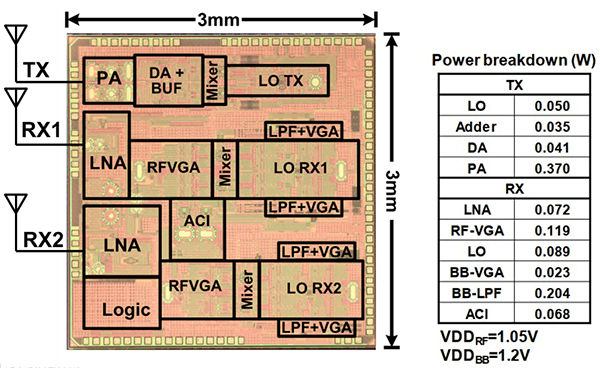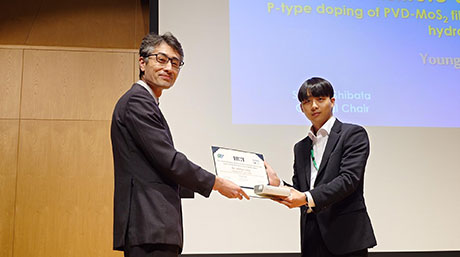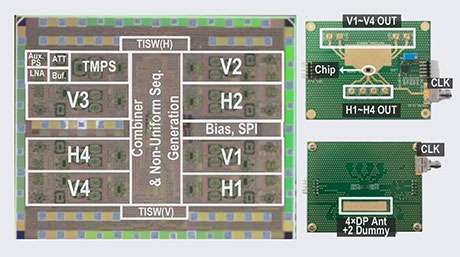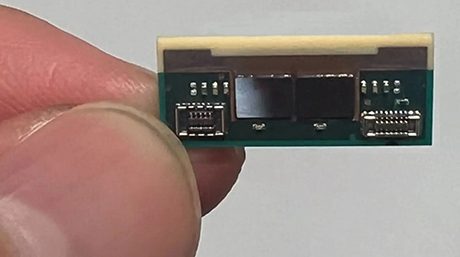Electrical and Electronic Engineering News
Greater Connectedness in Remote Areas: A Ka-band Transceiver for Satellite Communications
Scientists at Tokyo Institute of Technology and Socionext Inc. have developed a novel transceiver for enabling seamless communication between earth ground platforms and satellites in the low, middle, and geostationary earth orbits. Among other things, this transceiver could bring Internet to people in remote rural areas and at sea.

Figure 1. Prototype of the SATCOM transceiver and its power consumption characteristics
- The test chip only measures 3 mm by 3 mm.
We live in the information age, where communications technologies have reached unprecedented levels of advancement. Yet, bringing connectivity to remote locations, such as rural areas or the open sea, remains difficult. Satellite communication (SATCOM) is an attractive option for providing data links to such places; but for effective SATCOM, the right equipment must exist both in space and here on Earth.
At the forefront of research to achieve superior SATCOM are scientists from Prof Kenichi Okada's lab at Tokyo Institute of Technology (Tokyo Tech), who have developed a novel transceiver[1] for SATCOM using standard CMOS[2] technology. This transceiver operates in the "Ka band," which, for SATCOM, means a 27–31 GHz frequency range for uplink (ground to satellite) and 17–21 GHz range for downlink (satellite to ground).
Their design carries a variety of features that make it stand out from the competition. On the transmitter (TX) side, a high-quality-factor transformer is employed to achieve efficient power use and high linearity in transmission, which results in lower distortion during transmission. The receiver (RX) side features a dual-channel architecture that unlocks several capabilities.
First, having two RX channels allows for receiving signals from two satellites simultaneously. These signals are received in parallel using either two independent polarization modes or two different frequencies. In addition, the proposed design can perform adjacent-channel interference cancellation; that is, the "contamination" on a signal received in one channel by another signal on an adjacent frequency band is eliminated using information received at the other channel. This strategy increases the dynamic range of the system, thus allowing it to operate correctly even in less-than-ideal scenarios with stronger noise and interference.

Figure 2. Two RX channels support (a) dual polarization and (b) frequency multiplexing
Both the TX and RX perform direct conversion of a signal; that is, the TX directly converts a baseband signal[3] into a modulated signal[4] and the RX performs the inverse process without additional intermediate frequency conversions, unlike the more commonly used superheterodyne receivers. This makes the overall complexity, size, and power consumption of the transceiver considerably lower.
The scientists created a prototype chip to test the actual performance of their design when using all the modulation schemes regulated by the SATCOM DVB-S2X standard. This includes high-order modulation techniques like 64 APSK[5] and 256 APSK, which provide fast data rates.
The performance test results are very promising, especially when compared with other existing SATCOM transceivers, putting this developed novel design on the map. Prof Okada remarks, "Our paper presents the first Ka-band SATCOM transceiver implemented using standard CMOS technology and designed for an earth ground platform communication with geostationary and low Earth orbit satellites."
These orbits are at 35,786 km and 200–2,000 km, respectively. Communicating with satellites that far away from a 3 mm by 3 mm chip is certainly no simple feat.
For years, Prof Okada’s lab has been developing various types of state-of-the-art transceivers for next-generation technology, including 5G applications, Internet-of-Things-enabled devices, and low-power Bluetooth communications. This latest transceiver is another piece in the puzzle of enabling seamless worldwide connectedness. "Satellite communication has become a key technology for providing interactive TV and broadband internet services in low-density rural areas. Implementing Ka-band communications using silicon—CMOS technology in particular—is a promising solution owing to the potential for global coverage at low cost and using the wide available bandwidth," Prof Okada says.
Let us hope that the efforts of these Tokyo Tech researchers help more people benefit from instant communication in the current information era.
- Technical Terms
[1] Transceiver : A device capable of transmitting and receiving signals
[2] CMOS : Complementary metal-oxide-semiconductor; a modern type of fabrication process for transistors widely used for highly integrated circuitry
[3] Baseband signal : A signal in its "pure" form at its original frequency, without modulation
[4] Modulated signal : An encoded signal that carries all the information of a baseband signal, usually at a higher frequency so as to make it easier to transmit
[5] APSK : Amplitude and phase shift keying; a modulation technique where a baseband signal is encoded in both the phase and amplitude of a carrier signal
- Reference
| Authors : | Yun Wang1, Dongwon You1, Xi Fu1, Takeshi Nakamura1, Ashbir Aviat Fadila1, Teruki Someya1, Atsuhiro Kawaguchi1, Jian Pang1, Kiyoshi Yanagisawa1, Bangan Liu1, Yuncheng Zhang1, Haosheng Zhang1, Rui Wu1, Atsushi Shirane1, Shunichiro Masaki2, Daisuke Yamazaki2, Kenichi Okada1 |
|---|---|
| Title of original paper : | A CMOS Ka-Band SATCOM Transceiver with ACI-Cancellation Enhanced Dual-Channel Low-NF Wide-Dynamic-Range RX and High-Linearity TX |
| Conference : | IEEE Radio Frequency Integrated Circuits Symposium 2020 — RFIC2020 |
| Affiliations : | 1 Department of Electrical and Electronic Engineering, Tokyo Institute of Technology 2 Socionext |
- Smallest all-digital circuit opens doors to 5 nm next-gen semiconductor | Tokyo Tech News
- A more accurate, low-cost 39 GHz beamforming transceiver for 5G communications | Tokyo Tech News
- An ultra-low-power frequency synthesizer targeted for IoT devices: Digital PLL achieves a power consumption of 0.265 mW | Tokyo Tech News
- Tinier and less power-hungry quantum atomic clock push toward intelligent IoT | Tokyo Tech News
- Gearing up for 5G: A miniature, low-cost transceiver for fast, reliable communications | Tokyo Tech News
- New 28-GHz transceiver paves the way for future 5G devices | Tokyo Tech News
- Ultra high-speed IC capable of wireless transmission of 100 gigabits per second in a 300 GHz band | Tokyo Tech News
- Tokyo Tech slashes power consumption in Bluetooth Low-Energy transceiver by more than half | Tokyo Tech News
- Speeding up adoption of 5G! Wireless transmission speeds of 120 Gbps achieved | Tokyo Tech News
- Prof. Kenichi Okada awarded the 18th DOCOMO Mobile Science Award | Tokyo Tech News
- Kenichi Okada - Wiring the world wirelessly | Research Stories | Research
- Okada Lab.
- Researcher Profile | Tokyo Tech STAR Search - Kenichi Okada
- Researcher Profile | Tokyo Tech STAR Search - Atsushi Shirane
- Socionext Inc.
- Latest Research News
School of Engineering
—Creating New Industries and Advancing Civilization—
Information on School of Engineering inaugurated in April 2016
Further Information
Assistant Professor Atsushi Shirane
School of Engineering, Tokyo Institute of Technology
Email shirane@ee.e.titech.ac.jp
Tel +81-3-5734-3764






